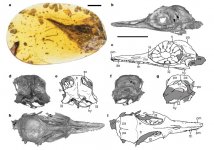Fred Ruhe
Well-known member

Lida Xing, Jingmai K. O’Connor, Lars Schmitz, Luis M. Chiappe, Ryan C. McKellar, Qiru Yi & Gang Li, 2020
Hummingbird-sized dinosaur from the Cretaceous period of Myanmar
Nature volume 579, pages245–249
Abstract: https://www.nature.com/articles/s41586-020-2068-4
Skeletal inclusions in approximately 99-million-year-old amber from northern Myanmar provide unprecedented insights into the soft tissue and skeletal anatomy of minute fauna, which are not typically preserved in other depositional environments. Among a diversity of vertebrates, seven specimens that preserve the skeletal remains of enantiornithine birds have previously been described all of which (including at least one seemingly mature specimen) are smaller than specimens recovered from lithic materials. Here we describe an exceptionally well-preserved and diminutive bird-like skull that documents a new species, which we name Oculudentavis khaungraae gen. et sp. nov. The find appears to represent the smallest known dinosaur of the Mesozoic era, rivalling the bee hummingbird (Mellisuga helenae)—the smallest living bird—in size. The O. khaungraae specimen preserves features that hint at miniaturization constraints, including a unique pattern of cranial fusion and an autapomorphic ocular morphology that resembles the eyes of lizards. The conically arranged scleral ossicles define a small pupil, indicative of diurnal activity. Miniaturization most commonly arises in isolated environments, and the diminutive size of Oculudentavis is therefore consistent with previous suggestions that this amber formed on an island within the Trans-Tethyan arc. The size and morphology of this species suggest a previously unknown bauplan, and a previously undetected ecology. This discovery highlights the potential of amber deposits to reveal the lowest limits of vertebrate body size.
Enjoy,
Fred
Hummingbird-sized dinosaur from the Cretaceous period of Myanmar
Nature volume 579, pages245–249
Abstract: https://www.nature.com/articles/s41586-020-2068-4
Skeletal inclusions in approximately 99-million-year-old amber from northern Myanmar provide unprecedented insights into the soft tissue and skeletal anatomy of minute fauna, which are not typically preserved in other depositional environments. Among a diversity of vertebrates, seven specimens that preserve the skeletal remains of enantiornithine birds have previously been described all of which (including at least one seemingly mature specimen) are smaller than specimens recovered from lithic materials. Here we describe an exceptionally well-preserved and diminutive bird-like skull that documents a new species, which we name Oculudentavis khaungraae gen. et sp. nov. The find appears to represent the smallest known dinosaur of the Mesozoic era, rivalling the bee hummingbird (Mellisuga helenae)—the smallest living bird—in size. The O. khaungraae specimen preserves features that hint at miniaturization constraints, including a unique pattern of cranial fusion and an autapomorphic ocular morphology that resembles the eyes of lizards. The conically arranged scleral ossicles define a small pupil, indicative of diurnal activity. Miniaturization most commonly arises in isolated environments, and the diminutive size of Oculudentavis is therefore consistent with previous suggestions that this amber formed on an island within the Trans-Tethyan arc. The size and morphology of this species suggest a previously unknown bauplan, and a previously undetected ecology. This discovery highlights the potential of amber deposits to reveal the lowest limits of vertebrate body size.
Enjoy,
Fred
Last edited:





